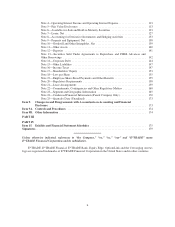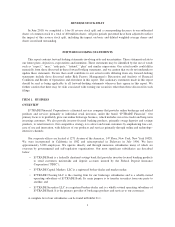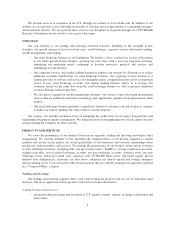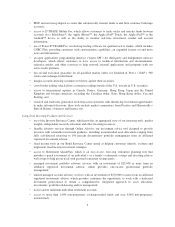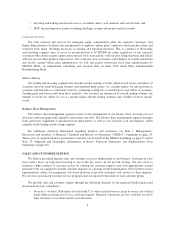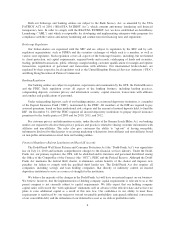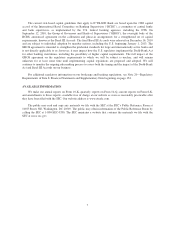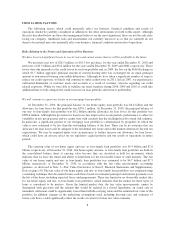eTrade 2010 Annual Report Download - page 13
Download and view the complete annual report
Please find page 13 of the 2010 eTrade annual report below. You can navigate through the pages in the report by either clicking on the pages listed below, or by using the keyword search tool below to find specific information within the annual report.E*TRADE Clearing LLC and E*TRADE Securities LLC) until those subsidiaries pay in full their respective
creditors, including customers of those subsidiaries and, as applicable, the FDIC and the Securities Investor
Protection Corporation.
We are subject to investigations and lawsuits as a result of our losses from mortgage loans and asset-backed
securities.
In 2007, we recognized an increased provision expense totaling $640 million and asset losses and
impairments of $2.45 billion, including the sale of our asset-backed securities portfolio to Citadel. As a result,
various plaintiffs filed class actions and derivative lawsuits, which have subsequently been consolidated into one
class action and one derivative lawsuit, alleging disclosure violations regarding our home equity, mortgage and
securities portfolios during 2007. In addition, the SEC initiated an informal inquiry into matters related to our
loan and securities portfolios. The defense of these matters has and will continue to entail considerable cost and
will be time-consuming for our management. Unfavorable outcomes in any of these matters could have a
material adverse effect on our business, financial condition, results of operations and cash flows.
Many of our competitors have greater financial, technical, marketing and other resources.
The financial services industry is highly competitive, with multiple industry participants competing for the
same customers. Many of our competitors have longer operating histories and greater resources than we have and
offer a wider range of financial products and services. Other of our competitors offer a more narrow range of
financial products and services and have not been as susceptible to the disruptions in the credit markets that have
impacted our Company, and therefore have not suffered the losses we have. The impact of competitors with
superior name recognition, greater market acceptance, larger customer bases or stronger capital positions could
adversely affect our revenue growth and customer retention. Our competitors may also be able to respond more
quickly to new or changing opportunities and demands and withstand changing market conditions better than we
can. Competitors may conduct extensive promotional activities, offering better terms, lower prices and/or
different products and services or combination of products and services that could attract current E*TRADE
customers and potentially result in price wars within the industry. Some of our competitors may also benefit from
established relationships among themselves or with third parties enhancing their products and services.
Turmoil in the global financial markets could reduce trade volumes and margin borrowing and increase our
dependence on our more active customers who receive lower pricing.
Online investing services to the retail customer, including trading and margin lending, account for a
significant portion of our revenues. Turmoil in the global financial markets could lead to changes in volume and
price levels of securities and futures transactions which may, in turn, result in lower trading volumes and margin
lending. For example, in the months following the abnormal intraday volatility (or so-called “flash crash”) of
May 6, 2010, retail trading levels declined significantly; our DARTs for the third quarter of 2010 declined by
26% over the preceding quarter and 30% over the same quarter in the prior year. In particular, a decrease in
trading activity within our lower activity accounts could impact revenues and increase dependence on more
active trading customers who receive more favorable pricing based on their trade volume. A decrease in trading
activity or securities prices would also typically be expected to result in a decrease in margin borrowing, which
would reduce the revenue that we generate from interest charged on margin borrowing. More broadly, any
reduction in overall transaction volumes would likely result in lower revenues and may harm our operating
results because many of our overhead costs are fixed.
We rely heavily on technology, and technology can be subject to interruption and instability.
We rely on technology, particularly the Internet, to conduct much of our activity. Our technology operations
are vulnerable to disruptions from human error, natural disasters, power loss, computer viruses, spam attacks,
unauthorized access and other similar events. Disruptions to or instability of our technology or external
technology that allows our customers to use our products and services could harm our business and our
reputation. In addition, technology systems, whether they be our own proprietary systems or the systems of third
10


